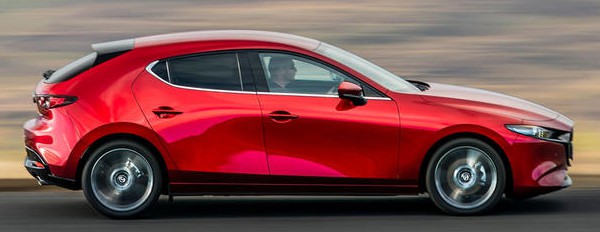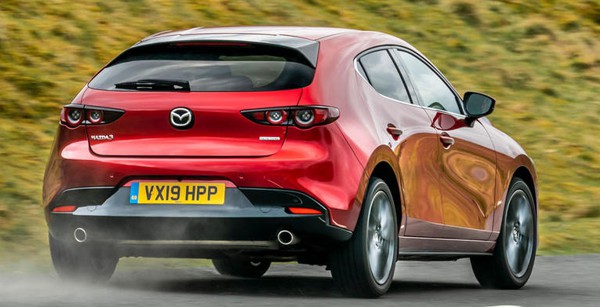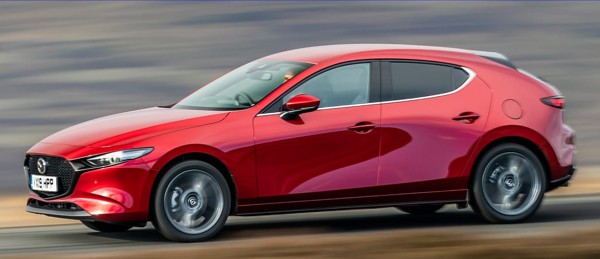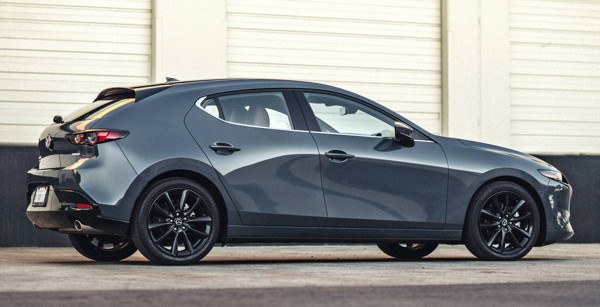Published
on 14
Mar 2020
|
All rights reserved.
|
|
|

|
|
Mazda
has built a stronger contender to the class laurel, and it is full of
character.
|
|
I really want to put the
4th generation Mazda 3 at the top of its class. Yes, who doesn’t
like its striking look? or its classy interior? or its innovative
Skyactiv-X engine? or its persistence in pleasing keen drivers? In the
increasingly familiar landscape of automotive industry, there are fewer
and fewer players dare to explore different directions. Volkswagen
group, for instance, used to chase engineering innovations and
excellence under the direction of Dr. Ferdinand Piech. Before it,
Mercedes had many world’s firsts. Even earlier, General Motors was the
world's most creative car maker (a sigh...). In the 1980s, Nissan and
Mitsubishi were the leaders of Japanese high-tech invasion. Oh, I
nearly forget
Honda for its countless of technological breakthroughs. Somehow, under
the threat of climate change, hence the risk of complete melt down of
the automotive industry, everybody turns to much the same solutions,
i.e. lithium batteries, permanent magnet motors, skateboard
architecture, electric torque vectoring… so boring to us. What
distinguish a Porsche Taycan from an 8-year-old Tesla Model S are just
the details. What separate a Mercedes A-class from BMW 1-Series from
Volkswagen Golf are no longer mechanical layouts but the interior
plastic textures or the software interfaces of their touchscreens. In
the new world order, there is not much for car enthusiasts to talk
about anymore, so bad! Fortunately, we still have Mazda left. From
Wankel rotary engines to Skyactiv-X, it has never changed its
adventurous heart. Yes, based on this reason alone, I really want to
put the Mazda 3 above all the
mainstream compact family cars.
 |
|
It
has a silhouette not unlike an Italian design masterpiece, Alfa Romeo
Brera.
|
|
I even like the idea that killed its Axela name in Japan and unify its
global nameplate, because a
strong product never needs more than one name. Localization is
meaningful only if the
products are really different and tailored to different needs of the
markets.
Otherwise, globalization is the way to go. The only thing differing the
Japanese market Mazda 3 from its European and American versions is the
availability of an
entry-level 1.5-liter Skyactiv-G engine, which qualifies for the
country's lower tax band. It is even offered the same Skyactiv-D diesel
engine as its European version.
This car is truly head-turning. Admittedly, its proportion is a bit
exaggerated, but it is not bad to get a little wild sometimes. The
Mazda 3 hatchback has a very long and pointy nose, a fast windscreen
and a silhouette not unlike an Italian design masterpiece, Alfa Romeo
Brera. It is the sports car in the family hatch class. By the way, the
last Mazda compact car giving me the same visual excitement was the
1993 Astina. As you see, great designs always live in people’s hearts.
I am not sure if the new car will be still remembered by today’s
teenagers 30 years later, but we can safely say it is the
most radical design among all family hatches at this moment. I
especially like its front grille, whose
semi-exposed ring is elegant. On the downside, the rear side windows
look too small to me, and it certainly has negative effects on
rear-quarter visibility and cabin ambience.
The sedan is also handsome. Its rear side windows are larger thus more
balanced. Unfortunately, the proportion is not. The Mazda’s
cab-rearward proportion means the front is long and the rear is
extremely short. A bit cartoonish.
 |
|
The
3-box sedan has a cartoonish proportion.
|
|
Size-wise, the hatchback does not differ much from the last generation.
It keeps the same length and width while cutting 10mm height and
boosting 25mm wheelbase – the latter is a class-leading 2725mm,
although you know the cab-rearward proportion doesn't help interior
space.
Compared with a VW Golf, the Mazda is a massive 200mm longer, and its
3-box version adds another 200mm. It is
also a little heavier than the class norm.
Inside, yes, it is not terribly spacious. In fact, a bit cramped. The
front seats are fine. Rear seat legroom matches that of the Golf, if
not the more spacious Ford Focus, but the problem is that sloping roof
line eating into headroom, which is a massive 60mm less than the Golf.
This means the rear seats are suitable to only shorter adults or
children. Just as expected, the small windows and thick C-pillars
result in a claustrophobic feeling and very poor rear-quarter
visibility, making reverse or lane-changing uneasy. For a striking
exterior design, the Mazda sacrifices some practicalities.
Even so, I still want to put it at the top of its class, because you’ll
find the best interior design and build quality in the
segment. Many talk about driver-focused interior design, but only Mazda
takes it so seriously. Its dashboard design looks as if taken from a
Porsche or Corvette. To keep you focused on driving, it refuses to use
fancy TFT instrument, or even a touchscreen for the infotainment
system. You access the latter through a BMW iDrive-like rotary dial on
transmission tunnel, which is easier to control while the car is
moving. The 8.8-inch display mounted above the center console is not
terribly large or filled with fancy graphics, but it keeps your sight
close to the road ahead. Moreover, head-up display is standard
equipment.

|
|
For
the first time a compact car’s interior can topple Volkswagen Golf for
quality perception.
|
|
For the first time, a compact car’s interior can topple Volkswagen Golf
for quality perception. The materials used are impossibly expensive for
this class, with plenty of great-looking and good-touching leatherette,
soft plastics and metallic trims. Not just that, all
switchgears deliver a quality feel when you touch and operate them. All
buttons are well damped and
rotary knobs have consistent feel, something used to be reserved for
Volkswagen. The infotainment system is well designed, intuitive and
responsive. Equipment level is high, although the Mazda has a price tag
as premium as Volkswagen.
Just a few years back, Mazda was often criticized for ignoring cabin
design and quality. It has really listened to customer voices and
worked
hard to lift its game, from the bottom of to the top of the class.
Great job!
Mazda has also worked hard on NVH suppression, resulting in a cabin
that is well insulated from wind and road noises. A stiffer chassis by
means of 30 percent ultra-high-strength steel is one of the reasons.
The use of tires with softer sidewalls is another. Unfortunately, part
of the work is offset by the decision to switch to torsion-beam rear
axle... Yes, the 3 has abandoned the multi-link rear suspension that it
has been persisting since its birth in 2003. That is a strange
decision, considering most of its arch-rivals keep using multi-link
setup (at least on more powerful models), such as Golf, Focus, Civic,
A-class, 1-Series, A3, i30, Ceed and even the new Corolla! How come
Mazda chose a backward step? Perhaps to offset the extra cost it spent
on the interior?
 |
|
If
you drive the car on the smoother roads, you might swear that it has
lost none of its driver appeal.
|
|
If you drive the car on the smoother roads that normally found in
Japan, Germany or North America, you might swear that it has lost none
of its driver appeal. This is still one of the best driving cars in the
class. Like an MX-5, its suspension setup is relatively soft, resulting
in a fair amount of body roll in corner, but the motion is progressive
and predictable, thanks in part to locating the driver right at the
center of the car. The steering is not very quick, lacking the
sharpness
and feel of Ford Focus, but it works precisely and loads up nicely in
corner. The
front-end bite is not as strong as Ford, too, but still it feels eager
to turn, agile and well balanced in corner. Lift off the throttle will
tuck in its nose a little, revealing a communicative chassis. All
controls deliver satisfying weight and feedback. Overall, it is not as
sporty as Ford, but very good nonetheless.
The downside is ride quality. On rougher roads, the torsion-beam axle
and 215/45R18 tires reveal their limitations. Big bumps can be still
dealt with satisfactorily, but smaller regularities on rough surfaces
make it feel harsher and noisier than the multi-link camp rivals. That
is a pity, because if not switching to the cheaper suspension, it could
have matched or beat Focus as the driver's choice, or matches Golf for
refinement. An opportunity lost.
Maybe the unique engines could claw back some points? The new 3 offers
a choice of Skyactiv-G, Skyactiv-D and Skyactiv-X engines. Let’s see
the diesel first. It is a new 1.8-liter unit, down from the last
generation’s (admittedly oversized) 2.2-liter, and its turbocharging is
simplified from sequential twin-turbo to a single VTG turbo setup. As a
result, output is reduced from 150 to merely 116 horsepower, while
torque sees an even larger reduction to 199 lbft. Generally speaking,
this is an acceptable motor, offering good mid-range torque and
satisfactory quietness, but its biggest problem is turbo lag – and a
lot. Just about any rivals offer better diesel engines.

|
|
Lacking
some world-class engines undermines Mazda's effort to make this a great
driver's car.
|
|
Anyway, most people are likely to opt for the Skyactiv-G petrol
engines. These includes 1.5-liter, 2.0-liter and 2.5-liter units. The
first one is restricted to Japan and the last one is reserved for
America. The 1.5-liter produces 111hp, not bad for a naturally
aspirated engine, but torque output is no match for rivals’ 1-liter
turbo, so you will need to work harder on gearchange to compensate.
Still, it is a joy to use the 6-speed manual gearbox, whose shift is
accurate, short and offers a satisfying mechanical feel, if not as
slick as Honda’s. The optional 6-speed automatic is also quite good a
companion for less enthusiastic drivers.
The Skyactiv-G 2.0 engine has two states of tune. It is rated at 156hp
and 147lbft in Japan, but in Europe the output drops to a laughable
122hp. Obviously this version runs more in Atkinson cycles to save fuel
and meet the stringent CO2 target in
Europe. Not only slow, the motor sounds unhappy to work at high rev,
seriously hurting the car's sporting pretension.
Naturally, the largest 2.5-liter engine is the best if you don’t
consider fuel economy. It runs the least aggressive fuel-saving
strategy thus it is also the closest to a conventional naturally
aspirated engine. 186 horsepower and pound-foot of torque lands 0-60 in
a tad over 7 seconds, quick enough to warrant its driver’s car status.
However, it still lacks the stronger mid-range torque as well as
refinement of turbocharged
motors, so in the real world it doesn't feel too quick or too relaxing.
The Skyactiv-G has never been renowned for a sweet top end delivery or
a great sound, so is this one.
Skyactive-X engine
As none of the above engines are exactly world-class, the novel 2.0
Skyactiv-X is the last chance for the Mazda 3 to win my favour – yes, I
really want to rank it to the top of the class. Mazda invested heavily
into its research and development. The Skyactiv-X is the closest thing
to HCCI (Homogeneous Charge Compression Ignition) engine, which uses
very high compression ratio instead of spark plugs to ignite air and
fuel mixture into combustion. In other words, HCCI is the gasoline
version of diesel engines. Since combustion is triggered by pressure
rather than spark flames, it happens quickly and at the same moment
throughout the combustion chambers, right when the piston reaches the
top dead center. Therefore it can make use of the entire power stroke,
producing more torque in each combustion. In contrast, conventional
spark ignition engines take time for spark flames to propagate in the
combustion chamber, so the combustion keeps happening when the piston
is going down, wasting some work done. In addition, the higher
compression ratio it uses also enhances thermal efficiency.
Furthermore, eliminating the high temperature spark flames reduces the
formation of NOx, making the engine easier to pass emission
regulations. For decades, manufacturers like Mercedes and GM did a lot
of research and experiment but still failed to bring HCCI to reality.
Why? Because gasoline is more volatile than diesel, thus it is
difficult to control the moment of self-combustion. Apart from
pressure, temperature of air and combustion chambers can also
influence. If combustion happens before or after the piston reaching
the top, it becomes what we call “knock”, cancelling power, generating
noise and vibration.
 |
|
Skyactiv-X
engine is a technical breakthrough, but it is not matured enough to see
real-world benefits.
|
|
Mazda’s breakthrough is to operate the engine just under the
self-combustion threshold, and then use spark ignition to help
triggering the combustion, so the firm calls it SPCCI (Spark Controlled
Compression Ignition) instead of HCCI. The Skyactiv-X engine runs a
compression ratio of 16.3:1, much higher than the 14:1 of Skyactiv-G
but not high enough to trigger combustion or knock in all situations.
Its main injection uses an ultra-lean air-fuel ratio of 37:1, compared
with 14.6:1 on conventional gasoline engines and also leaner than the
stratified mode of direct injection engines. When the piston reaches
the top position, it adds a small jet of fuel around the spark plug,
enriching the mixture of that area to 29:1. Then the spark plug ignites
the mixture, causes a small-scale combustion at around the spark plug.
Now the pressure increases immediately, exceeding the threshold and
triggering the self-combustion to happen throughout the combustion
chamber. It sounds easy, but the key is to control the ignition moment
precisely, so Mazda adds a pressure sensor right at the center top of
each combustion chamber to meter the pressure precisely.
Another problem is how to get so much air into the engine, as the
ultra-lean mixture requires more air. Mazda’s solution is to add a
small roots-type supercharger, which inevitably adds weight and cost to
the engine. The third problem is how to deal with the demand of high
power, because lean burn is efficient rather than powerful for a given
engine size. The Skyactiv-X switches to conventional spark ignition
combustion under higher loads and revs. To avoid the 16.3:1 compression
causing knock, it retards the intake valve closing, so that some fresh
air is drawn back to the intake manifold in the initial phase of
compression stroke, resulting in a lower compression ratio. Yes, the
same trick as what Skyactiv-G engine uses to switch between Otto and
Atkinson cycles.
So much theories, but how does the Skyactiv-X 2-liter perform in the
real world? Its numbers are okay, if not remarkable. Maximum power is
180 hp, while torque peaks at 165 lbft at 3000 rpm. As long as you see
it as a naturally aspirated engine instead of a supercharged one, it is
quite good, especially the peak torque arrives 1000 rpm or so lower
than usual. Mazda claims good performance, too, with 0-60 mph quoted at
7.7 seconds. However, in the real world it hardly feels as quick. The
extra torque is too subtle to feel. The Mazda 3 fitted with this engine
is still short of performance compared with its turbocharged rivals –
we are not talking about a Golf GTI but a Golf 1.5TSI, a Focus 1.5
Ecoboost or Civic 1.5T. Moreover, the Skyactiv-X engine lacks a sweet
manner. Despite strong effort to mask its rough noises resulting from
HCCI (see the photo, the engine is nearly encapsulated), it still
sounds as coarse as a mediocre diesel engine, no matter at idle or
under acceleration. It is also reluctant to visit its 6500 rpm limit.
Both the Skyactiv-X and Skyactiv-G 2.0 in Europe are equipped with 24V
mild-hybrid system to save fuel. On 18-inch wheels (who wants
the alternative 16-inch?), the Skyactiv-G emits 119 grams of CO2
each kilometer under
NEDC cycles, while the more powerful Skyactiv-X beats it with an
impressive 103 grams. That’s an improvement of 13 percent, accompanied
with free horsepower. However, a Golf 1.5TSI 150hp is quicker and far
more refined in the real world yet it emits only 6 grams more. Is the
Skyactiv-X worth so much investment? At the moment, the answer seems
negative. Keep developing the technology, 5 or 10 years later might be
another story – assuming ICE cars are not dead by then.
Yes, I really want to put Mazda 3 at the top of its class (how many
times I have said?), but unfortunately, its great looks, its good
handling and its quality interior are bundled with weak engines,
cramped rear seat and a slightly harsh ride due to downgraded
suspension. Even if you are a hardcore driver, you might forgive the
last
2 flaws but definitely not the first one. Give the car a world-class
engine and it may easily get my vote. Right now, it is just one short
of great.
|
Verdict:     |
Published
on 25
Nov 2020
|
All rights reserved.
|
|
Mazda 3 Turbo
|
|

|
|
Not
a hot hatch, but a more powerful extension of the Mazda 3.
|
|
We have been waiting for
this car too long. You know, Mazda 3 is one of the most driver-focused
family hatchbacks on the market. However, the last generation skipped a
high-performance model, which was available in the first and second
generation under the badge “Mazdaspeed” or “MPS”. It was a strange
decision, because we were sure it would have been a thrilling option
for driving enthusiasts. Now Mazda finally responds to our prayers by
introducing the Mazda 3 Turbo.
Expectation for this car is unquestionably high, especially when you
know it packs a 2.5-liter turbo motor and AWD system. Those
specifications sound like a Ford Focus RS or Subaru WRX STi, so you
might expect something possessing 350 horsepower and 0-60 mph in 4.5
seconds, cornering as if on rails, and stopping as good as a rally car.
Unfortunately, it turns out to be something else. Mazda calls it a
premium compact, indicating a direct rival to Mercedes A-class, Audi A3
and BMW 2-Series Gran Coupe. Hey, premium is fine, but we thought it
should have rivalled an AMG A35, S3 or M235i Gran Coupe instead of
their cooking sisters, because it runs a 2.5-liter Turbo and
all-wheel-drive. Otherwise, why would you waste money and fuel
consumption for the extra mechanicals?
The spec. sheet confirms our disappointment. This large motor produces
“only” 250 horsepower at a very unsporty 5000 rpm. Note that this is
achieved with 93 Octane premium fuel. If you feed it with regular fuel,
it will drop to 227 horses. On the plus side, its torque output is
remarkable, peaking at 320 lbft (or 10 lbft less with regular fuel),
although this arrives at a rather high, 2500 rpm. For comparison, the
latest Volkswagen Golf R offers 320 horsepower and 310 lbft of torque
from 2100 rpm, and it is achieved with a 2.0-liter engine. The Mazda
engine is not very power-dense because it is not designed to be a
high-performance engine. It comes straight from Mazda 6 and CX-9 SUV,
so it is designed to pull heavier cars with torque rather than to rev
and to produce high horsepower at the top end. Drivability and
flexibility of the large four-pot engine is good, as it features
“Dynamic Pressure Turbo” – the exhaust turbine is fed by a split intake
duct which closes one path at lower rpms, speeding up the exhaust flow
in another path, which is angled to hit the turbine blade at right
angle – like the function of VTG turbine but without the complexity of
variable vanes. Moreover, the system employs a 4-3-1 exhaust manifold
to separate exhaust flows from different cylinders, reducing
interference of pulses as if a twin-scroll turbocharger. Both improve
the low-end response of the turbo.
Still, 250 horsepower is nothing these days. It needs close to 6
seconds to pull the Mazda 3 Turbo from rest to 60 mph. Moreover,
although the engine is said to rev to 6300 rpm, it is not exactly
willing to do so, as the power is heavily concentrated at the
mid-range. The 2.5-liter also lacks an enthusiastic sound at the top
end, not even an electronic synthesizer could compensate. In short,
this motor feels too civilized, too grown up for a hot hatch.
The transmission fails to help either. Mazda makes an excellent 6-speed
manual gearbox for the MX-5, but it is not strong enough for this
engine, so the car is settled with a 6-speed automatic just like its
Mazda 6 and CX-9 siblings. This tranny is fine for a family car, but it
shifts too slow for a performance car, certainly no match for its
rivals’ DCTs or more advanced 8-speed automatic. It robs driving
excitement.
A similar story can be told for the chassis. Mazda relies heavily on
the fine handling and ride combination of the lesser Mazda 3, but
refuses to upgrade its chassis. What it did was only stiffened the
front springs by 15 percent to cope with the heavier powertrain and
tuned the dampers accordingly. There is no adaptive damper option,
while the rear axle remains to be torsion-beam. Tires are kept in
modest size of 215/45VR18, so grip level is unremarkable. Likewise, the
brakes are just the same as other AWD Mazda 3, so they don’t withstand
extended abuse. You still praise the balance of the car and the
faithful steering, but it just feels soft in too many areas, most
notably body control. Frankly, if Mazda stiffened its suspension, the
semi-independent rear axle could have ruined ride comfort more than its
rivals with multi-link setup.
In short, the Mazda 3 Turbo is not exactly a hot hatch. It is just a
more powerful extension of the regular 3. I wonder how many people want
such a combination.
|
Verdict:    |
|